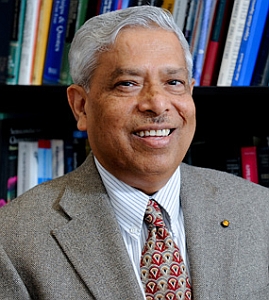A materials scientist at North Carolina State University in Raleigh discovered a new technique for making high-density ceramics needing lower temperatures and that takes only a second. Jay Narayan describes his process in two recent papers appearing online in the journal Scripta Materialia, a viewpoint essay posted last week, and a technical paper published last month (paid subscription required).
Ceramics are used in variety of commercial and industrial products, such as body armor, fuel cells, spark plugs, nuclear rods, and superconductors. The process developed by Narayan, a professor in NC State’s materials science and engineering department (pictured right), adapts a method for making ceramics called sintering that binds and compresses metalic powders, normally requiring high heat and long periods of time, often hours. The result of current sintering processes is a solid, but still somewhat porous material.
Narayan’s process selectively melts a material called yttria-stabilized zirconia, an ingredient used in ceramics applications including solid oxide fuel cells. The targeted melting of the material requires a lower temperature, 800 degrees celsius (C), instead of the conventional 1450 C. This process also accomplishes the sintering in less than one second, as opposed to four to five hours, and results in no porosity.
The technique applies an electric field, at about 100 volts per centimeter to the material. Applying this electric field, says Narayan, changes the material’s grain boundaries, where where atoms join from different crystals. The electric field draws defects — negatively-charged missing atoms — to the grain boundaries.
This draw of electric current to the grain boundaries then raises the temperature along the grain boundary, allowing the sintering to occur at a lower temperature, fusing together the crystals. Selectively heating the material along the grain boundary, explains Narayan, eliminates the need to preheat the entire mass of material, thus the lower overall temperature and much shorter time for sintering to take place.
Samples examined under an electron microscope show ceramics produced under this process have no porosity. “This technique allows you to achieve ‘theoretical density,’ meaning it eliminates all of the porosity in the material,” says Narayan. “This increases the strength of the ceramic, as well as improving its optical, magnetic and other properties.”
Read more:
- X-Ray Efficiency Boosted with Nanomaterials
- National Lab Develops Demonstration Community Fuel Cell
- Mass Production Process Devised for Micro Robots, Devices
- Silver Nanoparticles Generated in Natural Environment
* * *


 RSS - Posts
RSS - Posts
You must be logged in to post a comment.